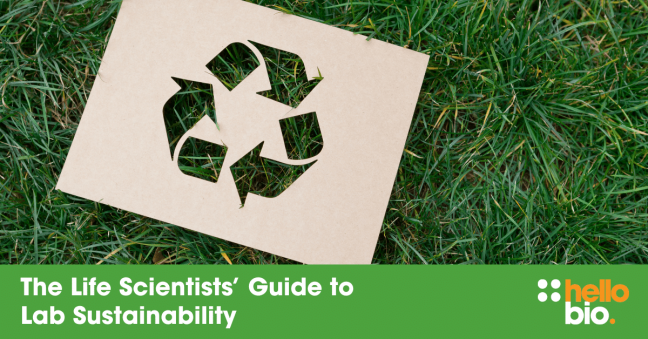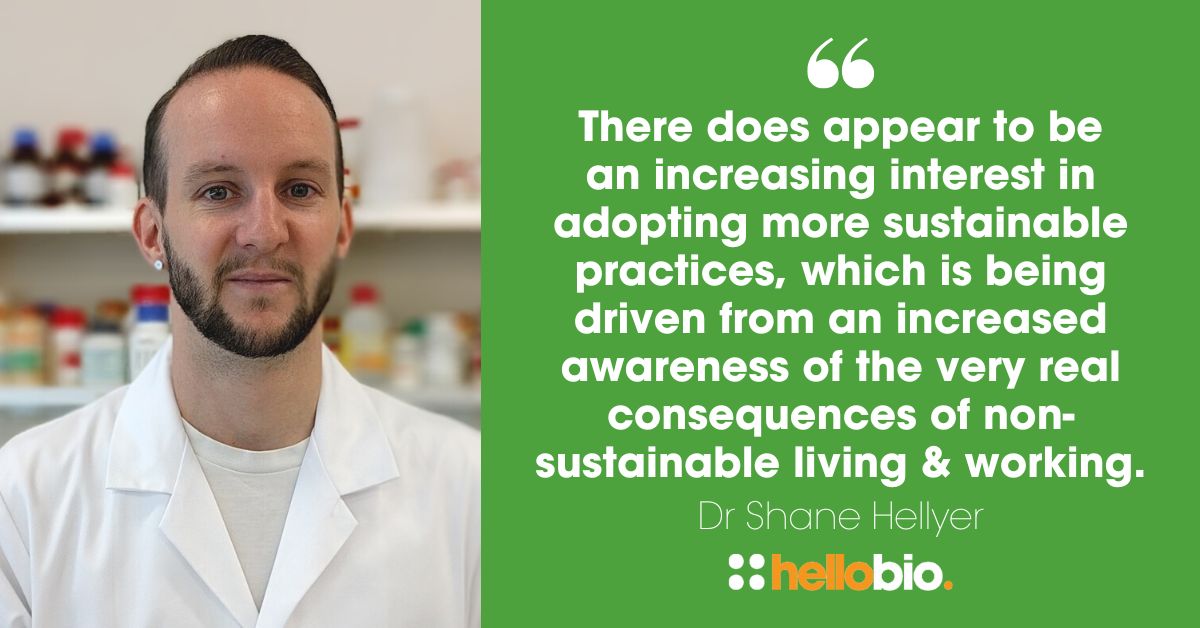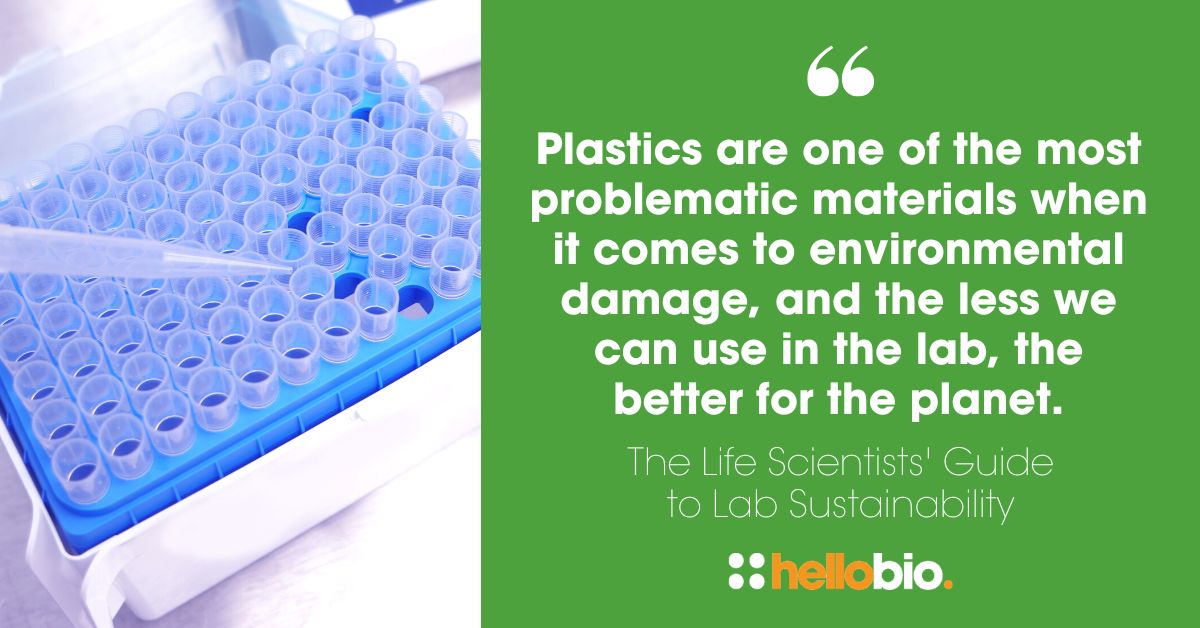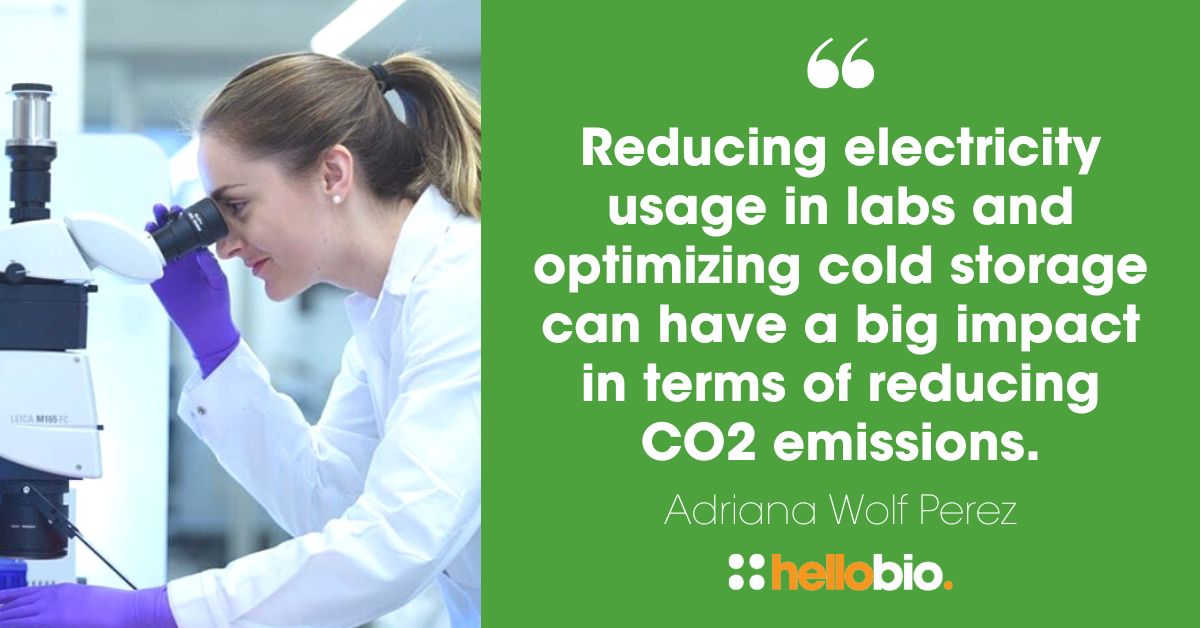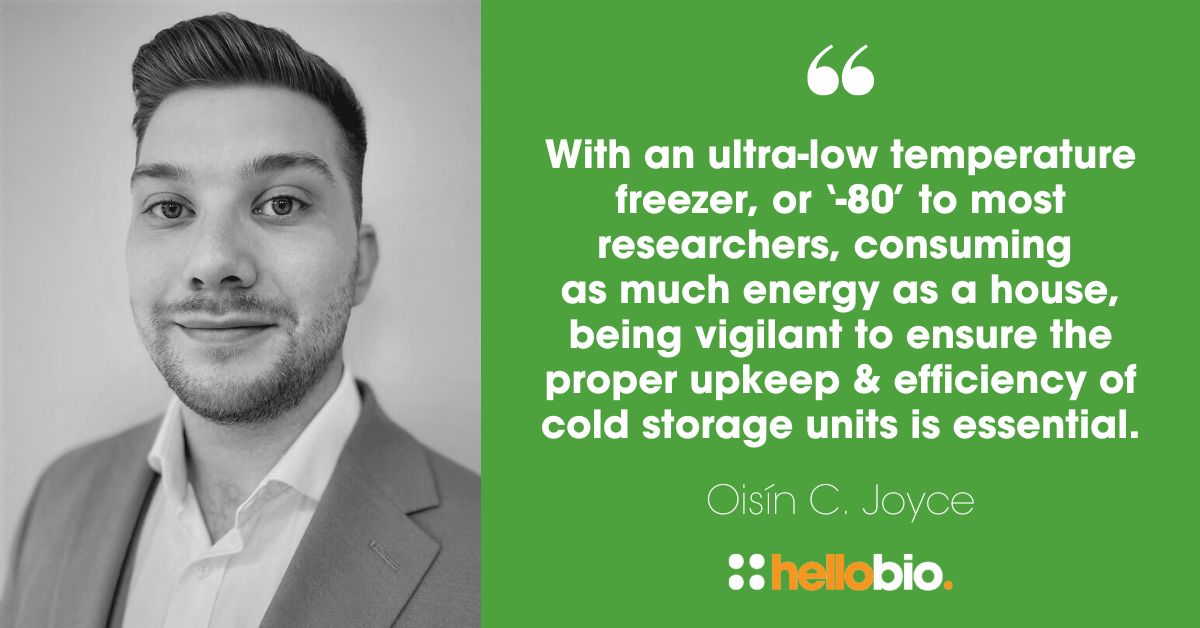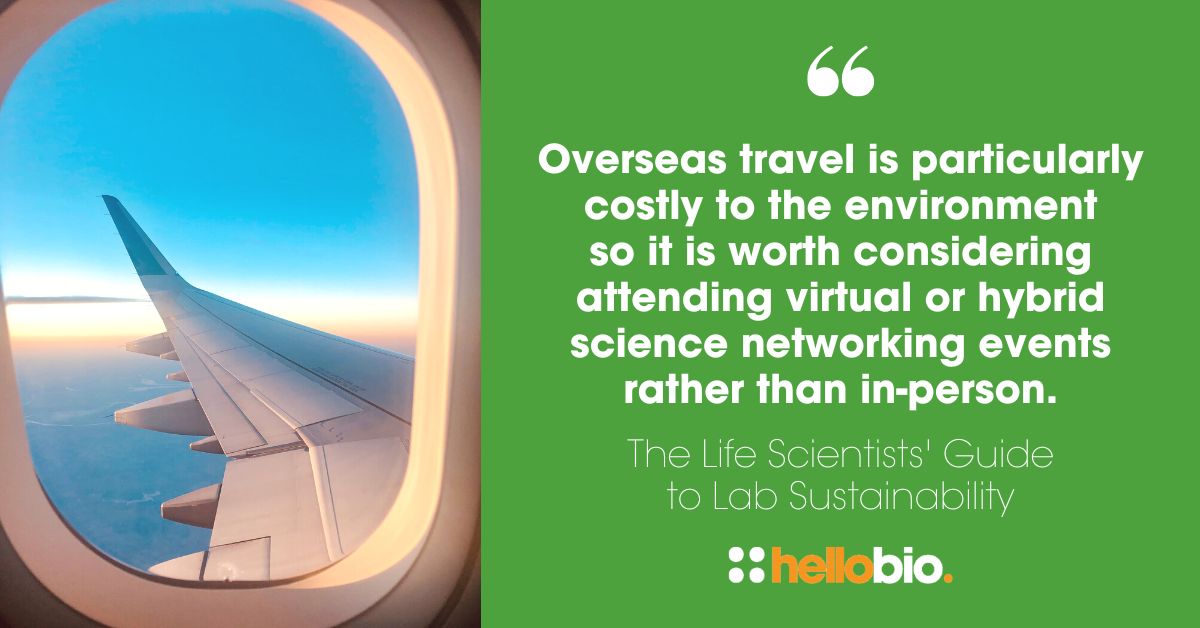The Life Scientists’ Guide to Lab Sustainability
As scientists we are doing everything possible to find a solution to the climate crisis, but are we doing all we can in our day-to-day lab operations to improve sustainability? How can we make our labs greener? What more could you do to make your lab eco-friendly?
We’ve gathered some practical advice from life scientists around the world to help you establish greener habits and push for better sustainability in your lab.
Why is lab sustainability important & what are the challenges?
Science research is essential for the future of mankind, but lab research itself has always had a significant environmental impact. Research labs are known to consume great amounts of energy, large quantities of water, and huge amounts of single-use plastic. As scientists we are all too aware of these problems, but with limited resources and an ever-increasing demand for results, sustainable practices aren’t always easy to prioritise in a busy lab environment.
Paul Disdle, a research technician and lab coordinator at the University of East Anglia, UK, told us: “Lab sustainability is very important to me and my colleagues, but it’s challenging to implement major improvements due to costs, or the need to replicate a previous process in the same way.”
In recent years, the threat of climate change has come to the forefront of global conversation, and it’s important that these conversations are carried on in the lab to encourage every scientist to play their part.
Shane Hellyer, a senior postdoc at Monash University, Australia, is passionate about increasing awareness. He told us: “Lab sustainability is something that has kind of bubbled under the surface for a while, at least in our lab. However, there does appear to be an increasing interest in adopting more sustainable practices, which I think is being driven from an increased awareness of the very real consequences of non-sustainable living and working. I think the personal ideals that people have towards sustainability in general are becoming more pervasive in the workplace, which is really getting other people to change their thinking and consider how they are approaching their work in the lab.”
Re-use & recycle
Most of us have been recycling domestically for decades, with the majority of local authorities making it pretty easy for us to confidently dispose of glass, aluminium, plastics and cardboard without the worry of it ending up in landfill. In workplaces however, this isn’t always so straightforward. When you’re up against tight deadlines and want results fast, taking those few extra moments to wash and reuse a piece of equipment or to sort discarded items into the correct recycling containers can feel like a burden.
Clarify the recycling rules
A great place to start in order to encourage recycling in the lab is to ensure everyone is aware of rules and that they know exactly where discarded items should go. Be sure that each new member of staff is fully trained on your recycling procedures so that there are no excuses. Build a recycling policy into your lab handbook, and don’t be afraid to speak up if people aren’t following the guidelines. Create posters or signs to remind your colleagues of the correct procedures, and ensure that recycling containers are clearly labelled to avoid any confusion.
In this great article by Anne Vielle of the University of Colorado Anschutz Medical Campus, USA, she told us how she and her colleagues have built the importance of sustainability into the philosophy of their lab. She said: “Recycling and energy-saving have become part of our lab philosophy, and we ask everyone on our team to follow a set of simple rules which also follow the Environmental Health and Safety regulations. We found that you can make a big difference by simply adopting a few good habits, such as buying a blue recycling bin for your paper, aluminium and plastic recyclables in the wet lab area, and recycling all cardboard and Styrofoam shipping containers.”
Removal of waste
Institutes and research buildings will have their own waste removal arrangements in place but it’s always good to check exactly what is included and if there’s anything more you can do to reduce what’s sent to landfill. Do some research into local waste disposal companies. It’s possible to find organisations that will collect certain types of recyclable waste for free which may not automatically be sent for recycling by your institution. You may even find schemes like the one Paul Disdle told us about, that handle very specific waste items that are traditionally more difficult to recycle: "We recycle as much material as possible. We have collected non-contaminated gloves for recycling via TerraCycle and Kimtech. This UK service is available in both small scale and bulk schemes. Fortunately, none of our waste goes to landfill as our waste handler takes it to a ‘waste-to-energy’ facility.”
Reducing the use of plastic
One of the biggest environmental concerns around life science research is the amount of single-use plastic used in experiments. Of course it’s essential that equipment is sterile in order to carry out experiments, and opening a fresh, sealed plastic pipette or tubing packet is the easiest way of guaranteeing there will be no contamination issues. However, plastics are one of the most problematic materials when it comes to environmental damage, and the less we can use in the lab, the better for the planet.
Shane Hellyer told us about his lab’s methods of reducing plastic waste: “We have a plastics recycling initiative, by which we can decontaminate and recycle any hard plastics such as compound plates, tip boxes, flasks and tubes, which goes a long way to reducing the amount of these items going straight into our waste.”
Swap plastic for glass
Try to use glass instead of plastics wherever possible. Consider investing in heavy-duty glass test tubes and petri dishes which can be sterilised easily and will be much more cost-effective in the long term. Get into the habit of sterilising items immediately after use.
Shane told us more about his lab’s methods “We try to wash and re-use any items we can (where appropriate) and use alternatives, e.g. glass beakers instead of plastic tubes. We make our own cell culture media from powder in reusable glass bottles, which reduces the number of plastic bottles we are generating.”
Packaging problems
Equipment and other items ordered for use in the lab will undoubtedly arrive well-packaged, especially if fragile, and although you have no control over how much bubble wrap a company chooses to use when they send an item to you, you can be mindful of the quantities you order. Try to buy in bulk and avoid ordering single items. This will not only help to avoid unnecessary waste, it will also be much more cost-effective. This issue was one of the many reasons that inspired Oisín C. Joyce of Trinity College Dublin, to become involved in Green Lab initiatives. In this fantastic article on sustainability, he told us: “I was concerned by the amount of packaging that I would have to break down and recycle after an order for one small vial that could fit in the palm of my hand!”
Conserve your energy
It’s a well-known fact that lab equipment such as computers, fridges and freezers, air ventilation systems and other instruments use a lot of power. In fact it’s estimated that labs use at least 3 times the amount of energy a regular office building uses. Proper storage of samples is essential in the lab, but Oisín reminds us of the cost: “With an ultra-low temperature freezer, or ‘-80’ to most researchers, consuming as much energy as a house, being vigilant to ensure the proper upkeep and efficiency of cold storage units is essential.” Adriana Wolf Perez of The Caring Scientist podcast agrees: “Reducing electricity usage in labs and optimizing cold storage can have a big impact in terms of reducing CO2 emissions.”
Of course the use of such items is vital in order to carry out experiments effectively, but there are plenty of steps we can take to minimise the amount of energy wasted in the lab. Here are a selection of tips from energy-conscious scientists:
Computers
- Be sure to turn off computer screens whenever not in use
- Switch off and unplug equipment in communal areas during weekends and holidays to avoid standby energy consumption or “vampire energy drain”
- Use laptops instead of desktops where possible
- Put computers in hibernation mode when on a break or at a meeting – standby mode can still use up to 50% of the energy they use when in operation
Fridges & freezers
- Review your samples in ultra-low temp freezers and switch them to -70 instead of -80
- Clean the coils and filters, and defrost regularly
- Take a look at the Freezer Challenge - a friendly energy-saving competition between universities
- Use recirculating chillers instead of using tap to drain to cool things
- Don’t store samples that you won’t need again
Lighting
- Turn off lights whenever not in use
- Put lights on timers to ensure they are all off overnight
- Install motion-sensor lighting where appropriate
Heating & air-conditioning
- Ensure that the temperature is optimised for both the lab equipment and personnel with energy conservation in mind
- Replace older systems with energy-saving alternatives
Fume cupboards
- Remind colleagues to keep fume hood sashes as low as possible and close them completely when not in use
Other electrical equipment
- Put timers on powerpoints so that unused electronic equipment turns off overnight
- Replace older pieces of equipment with newer, more eco-friendly models where possible
Water matters
As well as electricity, labs are known to use large quantities of water for both experiments and for washing and cleaning of equipment. Again there are some simple but effective things to remember when using water in the lab:
- Ensure all taps are closed tightly after use
- Wash equipment in larger loads rather than a single item at a time
- Install water misers on autoclaves and sterilisers
- Use timers for water valves and set them to the minimum necessary time
Saving paper
Where possible, try to reduce the amount of paper you use in the lab, especially for printing. Print only when absolutely necessary and try to establish digital lab handbooks and SOPs. Only order recycled paper and set your printer to ‘double-sided’ to get the most from your paper supply.
Shane Hellyer recommends the use of digital alternatives to paper wherever possible: “We use laptops and tablets to access our databases and online lab books, which helps to reduce paper waste from printed protocols.”
Sharing is caring
Another great way to reduce the use of resources is to share equipment and supplies with other labs within your institution. To do this effectively you will need a good system to keep track of resources and to ensure items are returned, reported if broken, or if supplies are running low. A lab manager or technician will usually be in charge of keeping track of equipment and ensuring the system runs effectively. Online inventories are commonly used to give instant access to stock levels and availability.
Shane told us about the challenges his team have faced when sharing resources: “While most labs in our department have their own consumables, there is a lot of sharing of equipment and resources. Our larger equipment is all booked through a central booking system, which makes the process easier. As for smaller equipment and everyday resources, this can be difficult to manage if labs are particularly strict on their funding being used exclusively for their lab, but there mostly tends to be a sharing attitude among the researchers.”
Online booking systems
Paul Disdle told us about the software used by his teams at the University of East Anglia: “We share resources and the system is managed by the tech team using Lab Archive software. However, we are soon to be moving over to Bookit by Clustermarket as it’s more flexible and easy to use. We have had it in place in Pharmacy for years, and after lockdown it was expanded to the whole faculty. We are also looking into ways to share purchasing. We have already implemented this for consumables like gloves and tissues but we should also be buying bio-based lab consumables in bulk as they are our biggest use of single use plastics.”
Remote options
Much science research came to an abrupt halt in 2020 during the COVID-19 lockdowns, with scientists unable to access their labs or continue with their experiments. We were all very relieved to return to our benches, but we should be mindful of the carbon footprint that our science research creates. Think about the amount that you travel for work, and consider choosing remote work options occasionally where possible, eg. for meetings or interviews. Virtual meetings are now commonplace and are a much greener option in cases where staff are travelling in just for that one appointment.
Conferences and overseas travel
Attending conferences, both home and abroad, is a big part of any researcher’s career, with face-to-face networking being important for career progression. However, overseas travel is particularly costly to the environment so it is worth considering attending virtual or hybrid science events rather than in-person. Many of the larger-scale conferences have continued to offer these options post-pandemic as they open up events to much larger audiences and will usually include virtual networking options.
Training programmes & initiatives
There are numerous support programmes, initiatives and training opportunities to encourage you and your lab colleagues to be more eco-friendly. Here are a few of the more popular ones worldwide:
My Green Lab
A non-profit organisation aiming to fundamentally and permanently improve the sustainability of scientific research. My Green Lab runs a number of different programs including My Green Lab Certification, the ACT Environmental Impact Label, the Freezer Challenge, Green Chemistry, and more. They also run annual online sustainability summits, as well as the Out of the Box podcast. Find out more here: www.mygreenlab.org
LEAF
LEAF (the Laboratory Efficiency Assessment Framework) is a tool developed by Sustainable UCL containing actions users can take to save plastics, water, energy and other resources in their labs. Those taking part in the self-assessment programme are awarded Bronze, Silver or Gold levels depending on how many sustainability actions they take. With online calculators, toolkits and other resources, LEAF is a great place to start if you want to identify possible improvements in your lab. Find out more: www.ucl.ac.uk/sustainable/leaf/take-part-leaf
NUS Green Impact Scheme
This United Nations award-winning NUS Green Impact Scheme is designed to support environmentally and socially sustainable practice within organisations by promoting behaviour change. The organisation runs a bespoke programme for universities, colleges and research institutes to support staff and students to learn more about sustainability in a holistic way. Take a look at their brochure here: https://greenimpact.nus.org.uk/universities-and-colleges-find-out-more
Labconscious
This online resource offers a blog sharing the latest developments in lab sustainability as well as advice and a guide to sustainable lab supplies and equipment. Their website also features a Lab Sustainability Training game to help you identify potential changes you could make in your lab, as well as guidance on best practices and links to grants and rebates for energy-efficient labs. Find out more: www.labconscious.com
Keep learning and help change the world!
Finally, it’s important to keep updating and refreshing your knowledge on lab sustainability. New ideas and initiatives are being introduced all the time, so stay on top of what’s happening through journals, websites and podcasts such as The Caring Scientist and Sustainable(ish).
More sustainability resources from Hello Bio
For more resources on sustainability, take a look at some of these other useful articles on the Hello Bio blog:
- To Sustainability and Beyond: Becoming a Green Lab Superhero
- Simple Ways To Make Your Lab More Eco-Friendly
- Podcasts By Scientists: The Caring Scientists
___________________________________________
If you enjoyed this article, why not check out the other resources available on our blog. We are passionate about supporting life scientists including early career life scientists and PhD students - with really low-priced reagents and biochemicals, early career scientist grants, and resources to help with both personal and professional development. We know how tough it is - so we hope you find these helpful!
More General Support for Life Scientists
For advice on writing papers, dissertations, presenting at conferences, wellbeing, PhD support, networking and lots more, we have a huge range of articles to help - just click below:
Save up to 50% on our high purity reagents...
When you get to the stage of planning your experiments, don't forget that we offer a range of low-cost, high-purity agonists, antagonists, inhibitors, activators, antibodies and fluorescent tools (yes - they really are around half the price of other suppliers!) You can use our Quick Multi-Search Tool to search for lots of products in one go, and the range includes:
- Enzyme inhibitors and activators
- Chemogenetic ligands
- Ion channel modulators
- GPCR & ionotropic receptor ligands
- Cell biology reagents & biochemicals
Technical resources
Try our Molarity Calculator: a quick and easy way to calculate the mass, volume or concentration required for making a solution.
Try our Dilution Calculator: an easy way to work out how to dilute stock solutions of known concentrations
And finally, don't forget to check back in with our blog regularly for our latest articles. If there’s something you’d love to contribute to the community, whether that’s an interview or article, drop us a line at hello@hellobio.com
---





